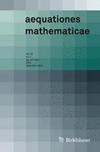The cosine addition and subtraction formulas on non-abelian groups
IF 0.9
3区 数学
Q2 MATHEMATICS
引用次数: 0
Abstract
Let G be a topological group, and let C(G) denote the algebra of continuous, complex valued functions on G. We determine the solutions \(f,g,h \in C(G)\) of the Levi-Civita equation
$$\begin{aligned} g(xy) = g(x)g(y) + f(x)h(y), \ x,y \in G, \end{aligned}$$
that extends the cosine addition law. As a corollary we obtain the solutions \(f,g \in C(G)\) of the cosine subtraction law \(g(xy^*) = g(x)g(y) + f(x)f(y)\), \(x,y \in G\) where \(x \mapsto x^*\) is a continuous involution of G. That \(x \mapsto x^*\) is an involution, means that \((xy)^* = y^*x^*\) and \(x^{**} = x\) for all \(x,y \in G\).
非阿贝尔群的余弦加减公式
让 G 是一个拓扑群,让 C(G) 表示 G 上连续复值函数的代数。我们确定了 Levi-Civita 方程 $$begin{aligned} g(xy) = g(x)g(y) + f(x)h(y), \ x,y \ in G, \end{aligned}$ 的解(f,g,h \ in C(G)),它扩展了余弦加法法则。作为推论,我们得到了余弦减法法则 \(g(xy^*) = g(x)g(y) + f(x)f(y)\), \(x,y \in G\) 的解 \(f,g \in C(G)\) 其中 \(x \mapsto x^*\) 是 G 的连续反卷。(x映射到x^*)是一个内卷,意味着对于所有的\(x,y in G\) ,\((xy)^* = y^*x^*\) 和\(x^{**} = x\).
本文章由计算机程序翻译,如有差异,请以英文原文为准。
求助全文
约1分钟内获得全文
求助全文
来源期刊

Aequationes Mathematicae
MATHEMATICS, APPLIED-MATHEMATICS
CiteScore
1.70
自引率
12.50%
发文量
62
审稿时长
>12 weeks
期刊介绍:
aequationes mathematicae is an international journal of pure and applied mathematics, which emphasizes functional equations, dynamical systems, iteration theory, combinatorics, and geometry. The journal publishes research papers, reports of meetings, and bibliographies. High quality survey articles are an especially welcome feature. In addition, summaries of recent developments and research in the field are published rapidly.
 求助内容:
求助内容: 应助结果提醒方式:
应助结果提醒方式:


